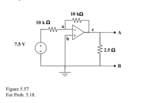paulmdrdo
Full Member level 3
Hello everyone! I need help on this problem I'm trying to solve. The ques is to find the Thevenin equivalent circuit. I was able to determine the Vth = -7.5v.
My calculation for the Rth = 20k ohms. But when look it up in the solution, it says Rth = 0 ohms
My process is to get first the Voc at the terminals and the Isc. Then Rth = Voc/Isc.
Can you explain as to why the Rth = 0 ?
Thank you!

My calculation for the Rth = 20k ohms. But when look it up in the solution, it says Rth = 0 ohms
My process is to get first the Voc at the terminals and the Isc. Then Rth = Voc/Isc.
Can you explain as to why the Rth = 0 ?
Thank you!
